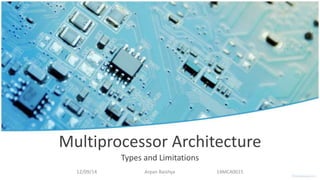
Multiprocessor architecture
- 1. Multiprocessor Architecture Types and Limitations 12/09/14 Arpan Baishya 14MCA0015
- 2. Contents Introduction to Multiprocessing Systems Types of Multiprocessing Systems Interconnection Structures Advantages of Multiprocessing 12/09/14 Arpan Baishya 14MCA0015
- 3. Introduction Multiprocessing is the use of two or more central processing units (CPUs) within a single computer system. The term also refers to the ability of a system to support more than one processor and/or the ability to allocate tasks between them. The term ‘processor’ in multiprocessor can mean either a CPU or an input-output processor (IOP). There are some similarities between multiprocessor and multicomputer systems since both support concurrent operations. However, there exists an important distinction between the two. In case of multicomputer systems, several autonomous computers are connected through a network that may or may not communicate with each other. On the other hand, in a multiprocessor system, processors interact with each other through an operating system and cooperate in the solution of a problem. 12/09/14 Arpan Baishya 14MCA0015
- 4. Classification Multiprocessors are classified by the way their memory is organized. There are two main kinds of multiprocessing systems:- Tightly Coupled Systems Loosely Coupled Systems 12/09/14 Arpan Baishya 14MCA0015
- 5. Tightly Coupled Systems A multiprocessor system with common shared memory is classified as a shared- memory or tightly coupled multiprocessor. This does not prevent each processor from having its own local memory. In fact, most commercial tightly coupled multiprocessors provide a cache memory with each CPU. In addition, there is a global common memory that all CPUs can access. Information can be therefore be shared among the CPUs by placing it in the common global memory. Symmetric multiprocessing (SMP) involves a multiprocessor system architecture where two or more identical processors connect to a single, shared main memory, have full access to all I/O devices, and are controlled by a single operating system instance that treats all processors equally, reserving none for special purposes. 12/09/14 Arpan Baishya 14MCA0015
- 6. Diagram 12/09/14 Arpan Baishya 14MCA0015
- 7. UMA & NUMA Uniform memory access (UMA) is a shared memory architecture used in parallel computers. All the processors in the UMA model share the physical memory uniformly. The UMA model is suitable for general purpose and time sharing applications by multiple users. Non-uniform memory access (NUMA) is a computer memory design used in multiprocessing, where the memory access time depends on the memory location relative to the processor. Under NUMA, a processor can access its own local memory faster than non-local memory (memory local to another processor or memory shared between processors). 12/09/14 Arpan Baishya 14MCA0015
- 8. Opteron 12/09/14 Arpan Baishya 14MCA0015 Opteron is AMD's x86 server and workstation processor line, and was the first processor which supported the AMD64 instruction set architecture (known generically as x86-64). The Opteron is a Non-Uniform Memory Access (NUMA) architecture.
- 9. Loosely Coupled Systems An alternative model of microprocessor is the distributed memory or loosely coupled system. Each processor element in a loosely coupled system has its own private local memory. The processors are tied together by a switching scheme designed to route information from one processor to another through a message-passing scheme. Loosely coupled systems are most efficient when the interaction between tasks is minimal unlike tightly coupled systems can tolerate a higher degree of interaction between tasks. 12/09/14 Arpan Baishya 14MCA0015
- 10. Beowulf Cluster 12/09/14 Arpan Baishya 14MCA0015 The Borg, a 52-node Beowulf cluster, is an example of a loosely-coupled system. It is a high-performance parallel computing cluster from inexpensive personal computer hardware.
- 11. Pros and Cons 12/09/14 Arpan Baishya 14MCA0015 Tightly Coupled Systems Loosely Coupled Systems Tightly-coupled systems perform better and are physically smaller than loosely- coupled systems, but have historically required greater initial investments and may depreciate rapidly. On the other hand, nodes in a loosely coupled system are usually inexpensive commodity computers and can be recycled as independent machines upon retirement from the cluster. Tightly coupled systems tend to be much more energy efficient than clusters. Considerable economy can be realized by designing components to work together from the beginning in tightly coupled systems Loosely coupled systems use components that were not necessarily intended specifically for use in such systems.
- 12. Interconnection Structures Some of the physical forms available for establishing an interconnection network between the components of a multiprocessor system are: Time-shared common bus Multiport memory Crossbar switch 12/09/14 Arpan Baishya 14MCA0015
- 13. Time-Shared Common Bus 12/09/14 Arpan Baishya 14MCA0015 Memory Unit CPU 1 CPU 2 CPU 3 IOP 1 IOP 2
- 14. Multiport Memory 12/09/14 Arpan Baishya 14MCA0015 MM 1 MM 2 MM 3 MM 4 CPU 1 CPU 2 CPU 3 CPU 4
- 15. Crossbar Switch 12/09/14 Arpan Baishya 14MCA0015 MM 1 MM 2 MM 3 MM 4 CPU 1 CPU 2 CPU 3 CPU 4
- 16. Advantages of Multiprocessing A benefit derived from multiprocessing is improved system performance. This happens because computations can proceed in parallel in one of two ways:- a) Multiple independent jobs can be made to operate in parallel. b) A single job can be partitioned into multiple parallel tasks. Increased Reliability: A failure or error in one part has a limited effect on the rest of the system. If a fault causes one processor to fail, a second processor can be assigned to perform the functions of the disabled processor. Increased Throughput: An increase in the number of processors completes the work in less time. It is important to note that doubling the number of processors does not halve the time to complete a job. 12/09/14 Arpan Baishya 14MCA0015
- 17. References Computer System Architecture, 3rd Edition by M. Morris Mano, Pearson Education Computer Architecture-A Quantitative Approach, 4th Edition by Hennessy and Patterson http://en.wikipedia.org/wiki/Multiprocessing http://en.wikipedia.org/wiki/Symmetric_multiprocessing 12/09/14 Arpan Baishya 14MCA0015
- 18. Thank You! 12/09/14 Arpan Baishya 14MCA0015